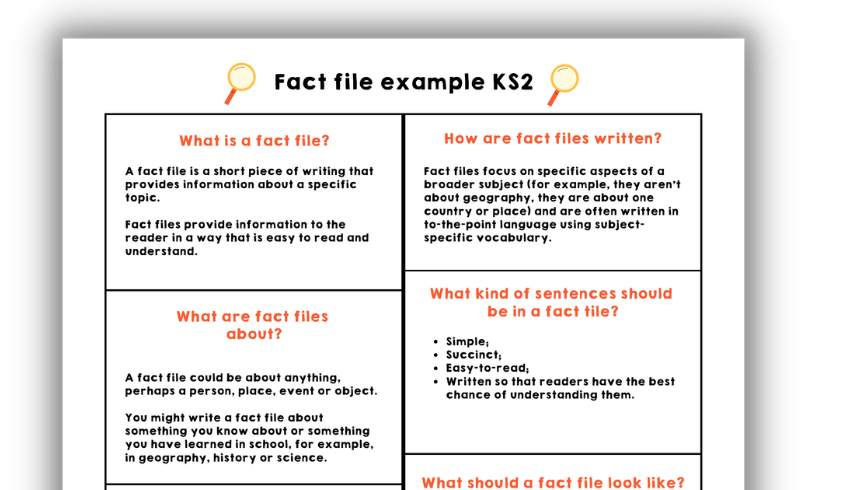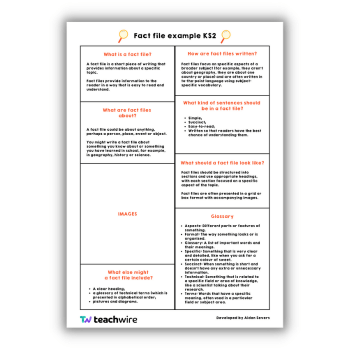Fact file example
Before they embark on writing their own fact file, show your students this fact file template. It will help pupils identify the key features of the text type. This will assist them in creating a set of criteria, or a toolkit, for when they eventually write their own.
What is a fact file?
A fact file is a short piece of writing designed to provide information on a particular topic. As a fact file is likely to be brief, as the writer you have to be careful to select the most salient points to include.
You’re effectively providing a summary or overview of the subject of the piece of writing. Because of this, fact files generally focus on specific aspects of a broader subject. For example, this might be:
- particular person
- place
- event
- object
Vocabulary
As fact files are short and focused, the writing is often to the point. It’s not overly complicated with regard to sentence structure.
“As fact files are short and focused, the writing is often to-the-point”
The main complexity of a fact file lies in the vocabulary that you use. The words you choose are often specific to the subject (tier 3 vocabulary).
As a fact file writer you need to consider the structure in which you present your information. This is alongside summarising the main points of a subject and using the relevant technical vocabulary.
Fact files should be easy to read. They therefore don’t require lengthy paragraphs. You may want to make use of a grid or boxes to present chosen short pieces of key information.
The organisation of a fact file also allows you to use images which support the text or provide additional information. These images are most likely to be photographs or diagrams.
Teaching children to write a fact file
Audience and purpose
Before embarking on any writing project, as writers we should consider our audience and the purpose of the text.
There are many different audiences for a fact file. However, the purpose is universal. It should inform the reader – potentially one who has no prior knowledge of the subject. It should do this in a succinct and well-communicated manner.
As a teacher, you can guide your class to achieve this purpose by carrying out the following steps in your teaching sequence.
Fact file features

The features of a fact file are as follows, although there are no hard and fast rules as to what can and can’t be included.
Fact file template
Title
Your title should succinctly sum up exactly what the fact file will be about. Children should recognise that a potential reader needs to know what the rest of the text is about from the title alone.
After all, when a reader is searching for the exact information they need, titles are the first place they will look.
Introductory section
This section should provide an overarching idea of what the fact file is about. Children are often tempted to start with ‘This is a fact file about…’. Show them that this isn’t necessary if you have a strong title and an appropriate introductory section.
Work with pupils to identify how this fact file example’s introductory section doesn’t go into too much detail. It allows the reader to check again that this fact file will likely contain the information that they want to find.
Headed sections
These sections – perhaps about three or four of them – should be about different aspects of the subject as outlined in the title and introductory section.
Sometimes children find it tricky to decide what information is most important. They therefore include a lot of extraneous content.
So, while sharing our fact file example, have a whole-class discussion about how content should be chosen in relation to the purpose of the text. Where appropriate, in Years 5 and 6, children can practise writing in bullet-point lists in some of these sections.
Images
These could be photographs, diagrams, maps or anything that supports the purpose of the fact file text, which is to inform the reader about a particular subject.
Children can often see images more as decoration rather than as distinctly informative, so your fact file should include relevant images. Discuss how they help the reader to understand more about the topic.
Glossary
Here, the definition of words used in the fact file is the main information required. They should support understanding of other sections.
Many of these words will be tier 3 vocabulary, so can support literacy as well as subject knowledge. Succinct definitions are exceedingly difficult to write, so it may be the case that you provide pupils with ready-made definitions. I recommend Kids Wordsmyth as a source of child-friendly definitions.
Challenge pupils to use the glossary words appropriately in their writing.
Content selection
As with explanation texts, it’s important that children have a good understanding of what they are going to be writing about.
This could be something that they have been studying at school (perhaps some geography, history or science content from the previous half term) which you are confident they have learnt enough about to be able to write about it.
Alternatively, ask pupils to write about a personal interest, themselves or their school – anything that they know lots about.
The third option is to ask children to write about something imaginary: a mythical creature of their own creation, for example.
Providing content
You might also choose to provide children with information for their fact file. This might be some facts written in note form which they then use to make a fact file.
“You might also choose to provide children with information for their fact file”
However, for pupils to be able to write well in full sentences about this information, they will need to have understood it well first. A reading comprehension lesson based on the information may help with this.
Providing questions
Providing children with a series of questions can help direct them towards selecting the most pertinent content. It will provide you as a teacher with some parameters within which to teach.
If you have opted for children to write fact files about different things it may be more difficult to provide a set of questions which can direct their thinking. But if the whole class is writing on the same subject, you can formulate a pretty basic list to share.
For example, if you’re studying India in geography, you might ask pupils to frame their fact file information around the following questions:
- Where in the world is India?
- What’s the climate like in India?
- What are the major cities of India?
- What are India’s main landmarks?
- Which languages are spoken in India?
- What is India known for?
In history, taking an Ancient Egypt unit as an example, you might ask children to develop a set of enquiry questions such as these:
- When did the ancient Egyptians live?
- Where is Egypt?
- What is Egypt like?
- Who was in charge in ancient Egypt?
- What were people’s lives like during this period?
- How do we know about the ancient Egyptians?
Word level work
For children to write a good fact file, they will need to have done lots of work on the words that they are going to use.
You should introduce them to the relevant vocabulary and provide them with definitions. You should also show examples of how this vocabulary is used in context.
Children need plenty of spoken and written opportunities to practise using these words correctly. One way to do this is to keep vocabulary journals in which you store words, definitions, example sentences and drawings.
Alternatively, you could challenge children to say or write a sentence containing a particular word. You can also adapt existing games to include subject-specific vocabulary.
For example, teams or individuals could win a Connect 4 token by correctly using a word, giving a definition for a word or identifying a word by its definition.
Spelling
When learning new words, their meanings and their usage, children should also learn to spell the words correctly. You can take this opportunity, where appropriate, to teach the morphology and etymology of the words.
Also refer to phonics learning that pupils are undertaking, or have undertaken in the past.
You can deliver this word-level work at the beginning of the learning sequence, but you can also continue it throughout as well. This gives children the opportunity to encounter the words many times, thus increasing their exposure to them.
This increases the chance of these words becoming part of their own vocabulary.
“Take this opportunity […] to teach the morphology and etymology of the words”
One potential feature of a fact file is a glossary of terms, as explained above. Where children use technical vocabulary, they may want to create a section of the fact file dedicated to providing definitions of key terms.
This is an exercise in writing like a reader – being mindful of the audience. It’s all about ensuring that everything you’ve written in the fact file is accessible to a reader who might know nothing about the subject.
Sentence level work
When teaching children to write sentences that are appropriate for a fact file, you may find yourself having to un-teach some of the things you have taught before.
The teaching of writing can often focus on composing increasingly complex sentences. However, the goal of a sentence in a fact file is to communicate full meaning as succinctly as possible.
The focus of your sentence-level teaching, regardless of the year group you teach, should therefore be on making appropriate choices.
As with the writing of any text, writers need to be mindful of the audience and purpose (see above) when writing at sentence level.
Children may know how to write multi-clause sentences, but in a fact file they may not be necessary. Carry out exercises where you give pupils choices about which sentences they would and wouldn’t use in a fact file. Provide them with long, complex sentences and challenge them to edit them into shorter sentences.
First draft
Once children have carried out such exercises, they should have a go at writing the sentences that they want to include in their own fact file. You can do the first drafts of these sentences verbally. Record them, if this is useful, on whiteboards and then in books.
It’s at this point of any writing teaching sequence that you need to prioritise giving feedback on what pupils have written. If you don’t give children feedback (and the chance to respond to it) at this stage in the process, the next drafts of their work will contain errors and misconceptions that you’ve not picked up on.
“Prioritise giving feedback on what pupils have written”
Posing and answering questions about the subject of the fact file is a sentence-level task that will support when children are working at text level.
Not only will posing a question give some direction to pupils as to which information to include (see the section on content selection above), it will also provide them with some simple headings. This can support them with organising their information on the page later.
If you’re a UKS2 teacher, you may want to take this opportunity to teach children to write in bullet-pointed lists, too.
Text level work
When children write an explanation text, the text-level focus is on grouping information into paragraphs. For a fact file, children will need to think more about how the sentences they have written (see above) will be organised on the page so that the reader can very easily access the information and learn about the subject quickly.
Again, we need to teach children to be mindful of their audience and purpose for writing.
As previously mentioned, children can begin to organise their content around a series of questions. These can provide them with short sections of information to arrange.
Examples of fact files will come in very useful when teaching children to arrange the information on the page. There are many ways you can do this, including:
- portrait
- landscape
- folded booklet
- leaflet
- using a grid or boxes
In order for children to find their desired layout, ask them to write out their information in the sections of a grid, cut them out, then move the pieces around like a jigsaw puzzle until they find the arrangement they want.
Some of these ‘jigsaw pieces’ may be images (see below) and headings.
Pupils may choose to use colour to highlight some sections or to differentiate one section from another. When children find the arrangement they think helps to communicate the information best, they can carry out a peer-assessment activity to ensure that a new reader’s understanding is supported by the layout.
Provide a success criteria for a good fact file layout to support children to give useful feedback to their peers. Once peer-assessed, pupils can glue their final arrangement onto another piece of paper, ready to inform a final draft.
Images
Drawing pictures and creating diagrams doesn’t really fall within the remit of a writing lesson. For this reason you might choose to provide children with a selection of relevant pictures and diagrams printed out to an appropriate size.
They can then select the images that best support their fact file. I find the photo printing options in Microsoft Gallery very useful for this.
Again, the emphasis here is on making good choices about which images are useful to the reader, and how they support the purpose of the text.
If you do want children to create their own imagery, you will first need to teach them to apply their knowledge about making appropriate choices based on their audience and purpose.
Aidan Severs is an education consultant and former primary teacher and leader. He now supports schools with curriculum and pedagogy. Visit his website at aidansevers.com

Similar resources
- No Refuge – Graphic novel activities about refugees for UKS2
- Short story writing – Author-led resources for KS1 and KS2
- Christmas activity sheets – KS1 / KS2 fun & educational printables
- Learning gaps – How to ensure no pupil drifts too far
- Writing horror – Write a scary scene with Fear Files: Hide & Seek










